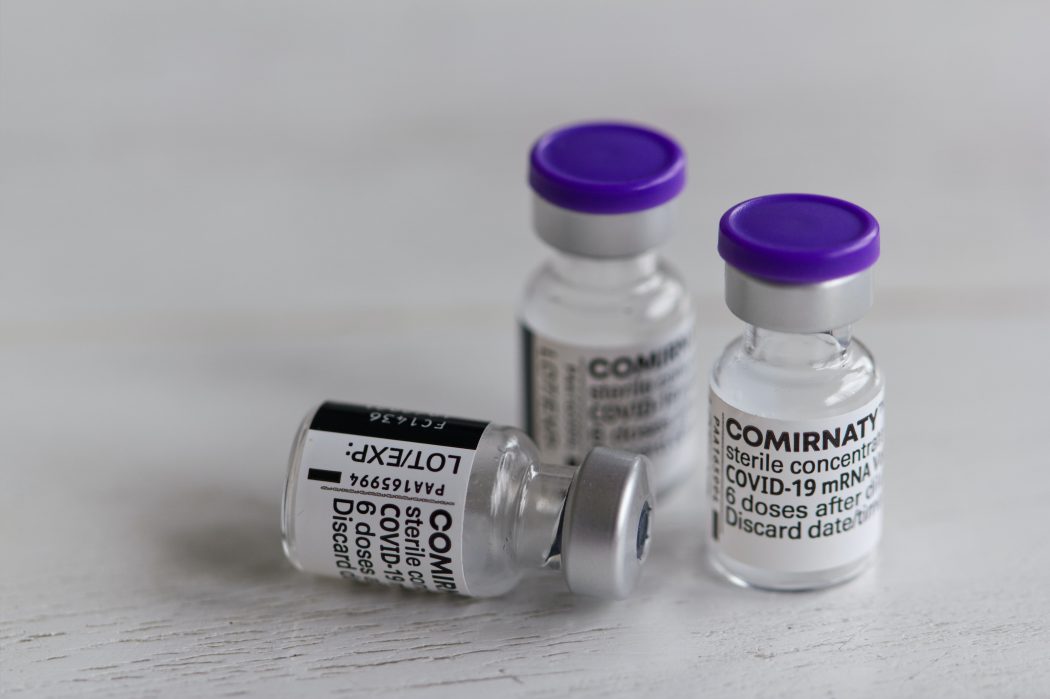To date, there have been over 370 million recorded cases of COVID-19 worldwide, with over 5.6 million deaths. The United States alone has had over 74 million recorded cases of COVID-19, and over 880,000 deaths [1]. As the pre-pandemic world we knew fades to a memory, COVID-19 vaccines continue to be on the forefront of social and political discourse. Currently, over 9.9 billion doses of COVID-19 vaccines have been administered worldwide[1], with over 537 million doses administered in the United States [2]. 211.3 million people in the United States are fully vaccinated [2], compared to 1.3% of people in low-income countries (as of the end of 2021) [3]. We are in a position unique to high-income countries in that we can argue about whether or not we will be receiving our vaccines, and find ourselves with ample supply of vaccines and boosters, while only a small fraction of vaccine doses promised to low-income countries have been delivered.
An October 2021 report by the People’s Vaccine Alliance (a coalition including Amnesty International, Oxfam, ActionAid, Global Justice Now, and UNAIDS) illustrates the severity of vaccine inequality: only 0.7% of all manufactured vaccine doses have gone to low-income countries, while high-income countries donate vaccine doses to other high-income countries. Of the 1.8 billion vaccine doses promised by high-income countries, only 261 million doses (or 14%) have been delivered [4]. While the United States has delivered more doses overall (nearly 177 million, a mere 16% of its 1.1 billion pledged doses), Japan has delivered a higher percentage of its pledged doses (31% of its pledged 19 million) [5].
Pfizer/BioNTech, Oxford/AstraZeneca, Moderna, and Johnson & Johnson all promised to deliver vaccine doses to the COVID-19 Vaccines Global Access (COVAX, an organization co-led by Gavi, the Coalition for Epidemic Preparedness Innovations, and the World Health Organization to provide equitable vaccine access); however Pfizer/BioNTech has only delivered 39% of a promised 40 million doses (or 1.4% of its total deliveries), and Oxford/AstraZeneca has only delivered 14% of its promised 720 million doses. Johnson & Johnson (promised 200 million doses) and Moderna (promised 30 million) have not delivered a single dose as of October 2021 [5].
The Moderna vaccine, which has taken the lead in protecting against COVID-19 infection, has been primarily sold to high-income countries. Of the 22 countries Moderna has sold to, none are low income. Comparatively, Pfizer has agreements to sell to five lower-middle income countries, and one low-income country (Rwanda) [6]. A major issue with COVID-19 vaccines sales is the lack of transparency in pricing. The United States reportedly paid $15 to $16.50 for each Moderna vaccine (in addition to the $1.3 billion in funding that the government provided to Moderna for vaccine development), compared to $22.60 to $25.50 per shot paid by the European Union, and $27 to $30 per shot paid by Botswana, Thailand, and Colombia (classified as upper-middle income countries) [6]. The CEO of Moderna, Stéphane Bancel, reports that vaccine dose pricing depends on how many doses are ordered and how wealthy a country is, putting lower income countries with smaller populations and less purchasing power at a disadvantage. Not surprisingly, Moderna’s market value has nearly tripled this year to over $120 billion [5], and the revenue forecast for 2022 reached an expected $13 billion in profit [5].
Depending on high-income countries to donate vaccines to lower income countries has proven unsuccessful, and non-standard pricing of doses leaves poor countries vulnerable. The People’s Vaccine Alliance organized to call upon leaders at the G20 summit in Rome in October 2021 to suspend intellectual property rights, require pharmaceutical companies to share COVID-19 vaccine development knowledge and technology, and invest in manufacturing hubs in developing and poorer countries that would allow for direct control over vaccine production needs [3]. They argue that rich countries hoarding vaccine doses allows for further viral mutation and leads to the possibility that current vaccines will become ineffective. In response, Moderna and Pfizer claim that the process of making the mRNA vaccines is too complex, and that it would require too much time and labor to establish new manufacturing centers [7]. The CEO of Pfizer Albert Bourla also warned that a waiver for vaccine technology could disrupt the supply of raw materials, “putting the safety and security of all at risk” [8].
At the G20 summit, finance and health ministers created a task force, the G20 Joint Finance-Health Task Force, with the lofty aim of “enhancing dialogue and global cooperation on issues relating to pandemic PPR [prevention, preparedness, and response], promoting the exchange of experiences and best practices, developing coordination arrangements between Finance and Health Ministries, promoting collective action, assessing and addressing health emergencies with cross-border impact, and encouraging effective stewardship of resources for pandemic PPR, while adopting a One Health approach” [9] to further support the World Health Organization (WHO) recommendations of vaccinating 70% of the global population by mid-2022. No specific details were given on how the Task Force would boost vaccine supply, increase medical products and inputs, or remove constraints on supply and financing to achieve this vaccination rate [10]. There was also no discussion on intellectual property rights or patent waivers.
In response, the international advocacy group Global Citizen said the world needed an actionable plan for how to achieve vaccination targets and greater transparency on vaccine manufacturing and distribution. Global Citizen’s vice president, Friederike Roder, says “It’s no longer the time for statements of intentions. Now is the time for our leaders to act” [10]. It seems unlikely that action will evade the ties of bureaucracy, greed, and economic disadvantage at this point when it has failed to do so over the past two years, but only time will tell.
References
- COVID-19 Dashboard, Global Map. Johns Hopkins University & Medicine Coronavirus Resource Center. https://coronavirus.jhu.edu/map.html. Accessed 29 January 2022.
- COVID Data Tracker. CDC. https://covid-cdc-gov.ezproxy2.library.arizona.edu/covid-data-tracker/#vaccinations_vacc-total-admin-rate-total. Updated 23 October 2021. Accessed 29 January 2022.
- A Dose of Reality, Broken Vaccine Promise Press Release. The People’s Vaccine Alliance. https://peoplesvaccine.org/g20/. Released 21 October 2021. Accessed 29 January 2022.
- A Dose of Reality. The People’s Vaccine Alliance. https://peoplesvaccine.org/g20/. Released 21 October 2021. Accessed 29 January 2022.
- Wealthy Countries Delivered Just 14% Of Covid Vaccine Doses Promised To Poorer Nations, Report Finds. Forbes. https://www.forbes.com/news. Published 21 October 2021. Accessed 29 January 2022.
- Moderna, Racing for Profits, Keeps Covid Vaccine Out of Reach of Poor. New York Times. https://www.nytimes.com/2021/10/09/business/moderna-covid-vaccine.html. Published 9 October 2021. Updated 13 October 2021. Accessed 29 January 2022.
- Here’s why developing countries can make COVID-19 mRNA vaccines. The Economic Times. https://economictimes.indiatimes.com/industry/healthcare/biotech/heres-why-developing-countries-can-make-covid-19-mrna-vaccines/articleshow/87217710.cms?from=mdr. Published 23 October 2021. Accessed 29 January 2022.
- “Today I Sent This Letter To Have a Candid Conversation With Our Colleagues About the Drivers of COVID-19 Access and Availability.” Albert Bourla. LinkedIn. https://www.linkedin.com/pulse/today-i-sent-letter-have-candid-conversation-our-drivers-bourla/?trackingId=6R9gEmJHTW2ifmmMksRoTQ%3D%3D. Published 7 May 2021. Accessed 29 January 2022.
- Joint G20 Finance and Health Ministers Meeting Communiqué. U.S. Department of the Treasury. https://home.treasury.gov/news/press-releases/jy0444. Released 29 October 2021. Accessed 29 January 2022.
- G20 wants 70% of world vaccinated by mid-2022, sets up pandemic task force. Reuters. https://www.reuters.com/business/healthcare-pharmaceuticals/g20-want-70-world-vaccinated-by-mid-2022-set-up-task-force-pandemic-fight-2021-10-29/. Published 29 October 2021. Access 29 January 2022.
Ann Staudinger Knoll is a member of The University of Arizona College of Medicine - Phoenix Class of 2023. After graduating from the University of Montana - Bozeman with a degree in Chemistry, she lived with her spouse and two perfect cats in New York City for six years before moving to the dusty Southwest for medical school. She enjoys volunteering, staying up to date on new films and tv shows, and eating any and every dessert.


